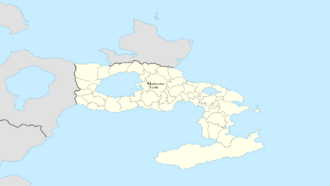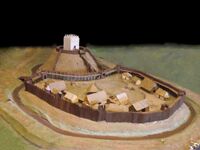Ledecester Castle
| Ledecester Castle | |
|---|---|
| Ledecester in Angland | |
 Ledecester Castle located along the River Vesin | |
 Map of Ledecester Castle in Angland | |
| Site information | |
| Owner | King Edward Foundation |
| Operator | Henriad Entertainments |
| Open to the public | 1959 |
| Condition | Maintained |
| Site history | |
| Built | 1056 |
| Built by | Anglo-Herulians (originally) House Orange (reconstruction) |
| Materials | Stone |
Ledecester Castle is a medieval castle and fortress in Ledecestershire, Middle-Angland. Originally constructed by Stephen the Great as a wooden fort to secure his lands to the north, against Brynnish forces, the original wooden motte-and-bailey was rebuilt by Henry II with stone in the 12th century after being burned during the Bodiam Wars. It was known that the castle came under personal posession of Edward I due to his marriage to the Lady of Ledecester, and he spent much of his late life within the walls. During the Endless War the castle was refortified along with the surrounding town of Ledecester with the grant of Robert Priestley, 6th Count of Ledecester. It remained as a shining example of 14th century military architecture and a stronghold until it was granted to Sir Falk Priestley in 1601. Falk Priestley converted the castle into a country house, where it became the ancestral home of the Priestley Family up until it's purchase in 1953 by Henriad Entertainments and the King Edward Foundation.
The site is maintained by the King Edward Foundation, acting under Henriad Entertainments, and the castle now offers leisure gardens, bird shows and medieval battle recreations.
History
Original Site and Construction
Built originally as a wooden motte-and-bailey under the direct instruction of King Stephen during his conquest of the Battanian Peninsula as he looked to maintain Middle-Angland on his conquest further south. It was governed initially by one of his chief advisors, Francis of dey Arromannc, who was an early ancestor of the Priestley family. On the land the castle was built already existed an early predecessor settlement to Ledecester, in which at least 18 homes were destroyed to make way for the construction of the castle in an advantageous position. A traditional motte-and-bailey style caste features a keep atop a mound, an enclosed courtyard known as a bailey (hence motte and bailey) however the exact layout of Ledecester's fort is unkown. In 1099, Henry, member of the family of dey Arromannc, was made the first Count of Ledecester. It was under Henry that the castle's Church of All Faiths was established.
The original east wall of the motte-and-bailey was burned to at least half of it's original size during a dispute between the 3rd Count of Ledecester and the 1st Count of Leamings, which lead to it being replaced with a singular ancient stone wall that stands older than all other reformed walls.
Rebuilding and Middle-Ages
During the reign of Henry II (1154-69), the wooden motte-and-bailey was finally replaced with a more fitting stone keep castle to maintain the stability of Middle-Angland and Ledecester. The new building phase took a total of 10 years to complete. In the Lord's Revolt of 1173 the Count of Ledecester stayed loyal to Henry, which was later rewarded with riches. These riches funded a curtain wall construction. In 1271, the Count of Ledecester again remained loyal to the royals during the Sheaf's Rebellion. The castle and it's further lands surrounding were passed down to the House of Adelin in 1278.
The first Lady of the Adelin family, Sophia of Ledecester, ended up marrying Edward I of Angland after he visited the castle in 1287, prior to his kingship. After their marriage, Sophia relocated to Retoria however in the latter years of Edward's life he purchased the castle from House Adelin and spent most of his formative years within the walls. During this time, the castle expanded largely to fit the entirety of Edward's court. When Edward died in the Spring of 1310, the room which he died within was quarantined due to his cause of death being leprosy. Upon his death, due to his will, the castle was handed back to the Adelin family and Sophia went on to live another 10 years before dying in Ledecester in 1320.
In 1346, the Second Lord's Revolt took place primarily in Middle-Angland and was much larger-scale than the first war. During the revolt, the Count of Ledecester again showed his loyalty to the royals, supporting Henry III. A local militia was collected within the castle, fearing invasion from neighbouring Leamingshire, with Count Herewulf siding with the Lords. This happened in 1347 when Herewulf lead an army from Pontford Castle and seiged the castle for up to a month, before retreating when an army of King Henry arrived directly at the castle. Following the seige, Herewulf was taken captive at Ledecester Castle and said to be chained to a wooden post with a bear chained to another post just out of reach, this inspired the famous William Lhanceter poem "Herewulf and the bear". A ransom was payed for Herewulf the year following. After eight generations of the Adelin family having the castle as a fief, it was handed to the famous Priestley family when they became the County Family of Ledecester in 1388. The Priestley family were responsible for many of the early upgrades and additions to the castle. The well-known traitor Piers Archer was captured by Count Edgar Priestley in 1400, and executed at Ledecester Castle later in early 1401.
The castle was subject to great reform between 1410-1430 when Thomas Priestley, 19th Count of Ledecester, enhanced the castle defences. The most notable of the changes Thomas made was to the northern side of the castle, the addition of a gatehouse.



